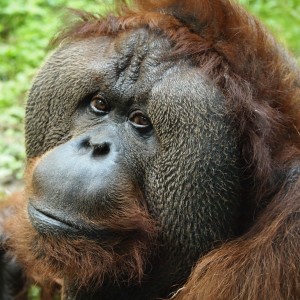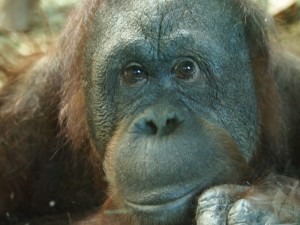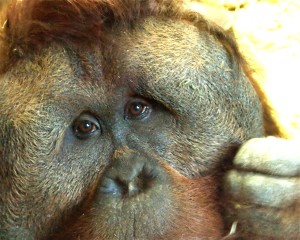.
In 2010 I was cast as the orangutan “Maurice” in the film Rise of the Planet of the Apes. As part of my research I went to Woodland Park Zoo in Seattle, Washington to study Towan. The meeting was unforgettable and Towan completely inspired my portrayal of “Maurice.” In 2011 after the film’s release, I was invited for a personal introduction to Towan and the other orangutans who live there: Melati, Chinta, Bela and Heran. I brought a gift of art supplies to this meeting. Like me, Towan was a painter. I had the opportunity to watch him paint and it was mesmerizing: he chose his colors, studied his canvas, moved it from here to there to consider the work in progress, remained utterly focused on the painting until he decided it was done.
I returned two months later in January 2012, bringing my own paints and canvas. As I was painting for Towan and his daughter Bela to watch, there was a knock on the glass next door – it was Melati, gesturing for me to come paint for her too. So I did, and that was the beginning of a journey that continues today. I visit for two or three days at a time, and sit in what I’ve come to call painting “conversation.” Most often with Melati, who loves to pick colors and will happily watch painting for hours. Chinta enjoys watching too. Heran has surprised me the most. For the first six months I visited I thought he took no notice of me – until June 2012 when he brought chalk to the window and scrawled a purple squiggle at my knees. Several months later I watched him discover the joy of putting two colors together: blue and yellow.
The journey to get to know each of these five magnificent orangutans as individuals, to learn about orangutans as a species and the people working so hard on behalf of their conservation and care, has become a treasured part of my life. It was a great loss and sadness when Towan, who gave me the heart and soul of “Maurice,” passed away in March 2016. At the time he was the oldest male orangutan in North America. His remarkable presence lives on, and I will always be inexpressibly grateful for his generosity to me.
About Orangutans
As the only Asian great ape, orangutans live only in Asia, in northern Sumatra and Borneo, where they exist as three distinct species (Borneo, Pongo pygmaeus and Sumatra, Pongo abelii and Pongo tapanuliensis).
All species are now listed as Critically Endangered on the World Conservation Union (IUCN) Red List of Threatened Species. The greatest threat to their survival is the destruction and conversion of their forest habitat, especially the large scale conversion of forests for monoculture oil palm plantations, and fragmentation of the forest by roads.
Orangutans share 97% of their DNA with humans. They are the only truly arboreal ape, the only ape that doesn’t live in large social groups, and they are predominantly frugivorous – eating mostly fruit and leaves, but they will also eat insects such as ants and termites as a source of extra protein too.


